Day 1 of a three day long weekend of tours today. It was a sunny start to the day, hot and humid. While we didn’t see any of the forecast thunder storms this afternoon, we did have some cloud and some rather patchy light rain late on, certainly not enough to really hinder us overly though.
The start of the day saw us heading inland to explore some farmland. We found somewhere to park by a convenient track and as we got out of the car, a Blackcap was singing from the willows nearby. A Reed Warbler was a bit more of a surprise here, singing from the same area as the Blackcap. It was not really classic Reed Warbler territory, but they do sometimes turn up in different habitat. A smart male Yellowhammer was perched up on the wires.
As we walked up the track, there were lots of finches which came out of the hedges and flew up to the wires. They were mostly Linnets, including a fine red-breasted male, plus a few Goldfinches and a single Greenfinch. A Lesser Whitethroat started singing from deep in the hedge, a little warble followed by a dry rattle, and eventually we got a couple of glimpses of it as it flew off back the way we had come. A Common Whitethroat was calling along here as well.
The surprise here was a Marsh Harrier which we flushed out of the hedge ahead of us. It came flapping out across the track, heading out over the field the other side before circling over us. It looked like it was probably a young bird from last year, so presumably just wandering round the area.
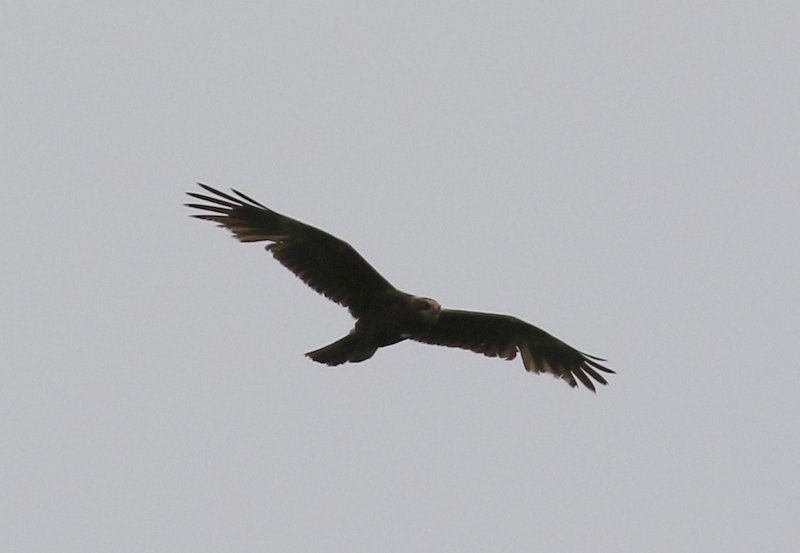 Marsh Harrier – flushed out of the hedge ahead of us
Marsh Harrier – flushed out of the hedge ahead of us
A Red-legged Partridge ran off along the track ahead of us. Another Yellowhammer started singing from the top of the hedge. Then we came across a flock of Long-tailed Tits which made their way quickly passed us along the line of bushes before flying up into some trees nearby. We could hear a Goldcrest singing too.
At the top of the hill, we stopped at a convenient gap in the hedge to scan over the fields. There were quite a few raptors on view now. A Kestrel was perched on a post. As the air began to heat up, several Common Buzzards started to circle up in the distance. A couple of Brown Hares were sitting opposite each other across a large open field, but they didn’t seem inclined to engage in any boxing today.
As we started to make our way back to the car, we heard a Yellow Wagtail calling. It flew across the track behind us, out across the field, and after a few seconds flew back across the track in front of us. Yellow Wagtails used to be fairly common breeding birds in Norfolk but have declined alarmingly in recent years. A very few pairs still cling on in north Norfolk, breeding in farmland.
There were a few butterflies out this morning. A Speckled Wood was particularly accommodating, perching nicely in the sunshine on some ivy for a minute or so, for the photographers in the group.
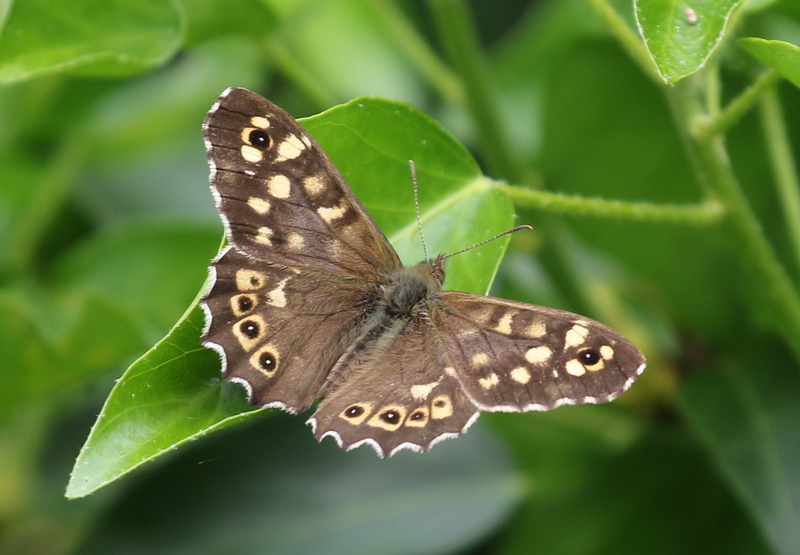 Speckled Wood – perched nicely in the sunshine for us
Speckled Wood – perched nicely in the sunshine for us
Our destination for the afternoon was to be Titchwell. As we drove back round and down towards the coast, we found several Red Kites out hunting now over the fields beside the road.
The main car park at Titchwell was full when we arrived, so we had to park in the overflow area. Even here, there were already quite a few cars and people. We had hoped to find one of the Turtle Doves here, but it was probably too disturbed. We stopped to watch a family of Long-tailed Tits. One of the youngsters perched out in the open, frozen in an odd pose, for some time. It seemed to be sunning itself! While we were watching it, we heard something hit one of the cars nearby and turned to see a Cetti’s Warbler flying off. It seemed to be unaffected by its collision and started singing again as soon as it got back into cover.
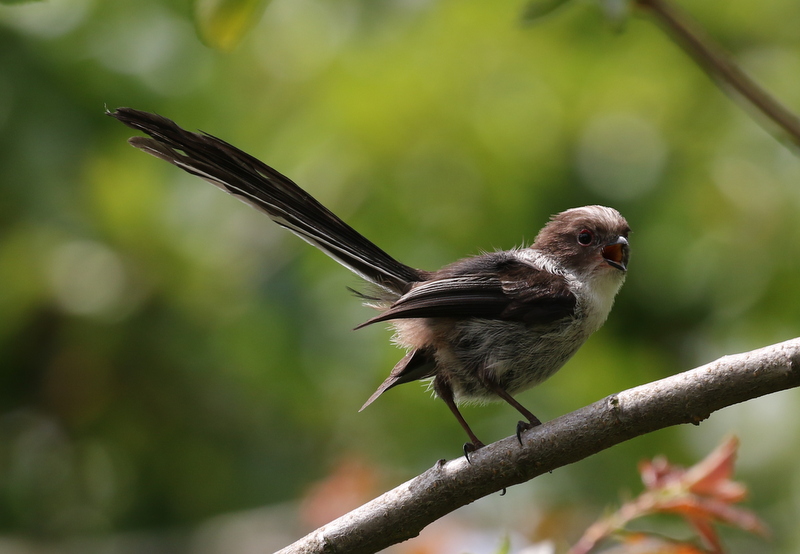 Long-tailed Tit – this juvenile appeared to be sunning itself
Long-tailed Tit – this juvenile appeared to be sunning itself
There were also a few dragonflies on the brambles in the car park – a Four-spotted Chaser, Blue-tailed Damselfly and Azure Damselfly.
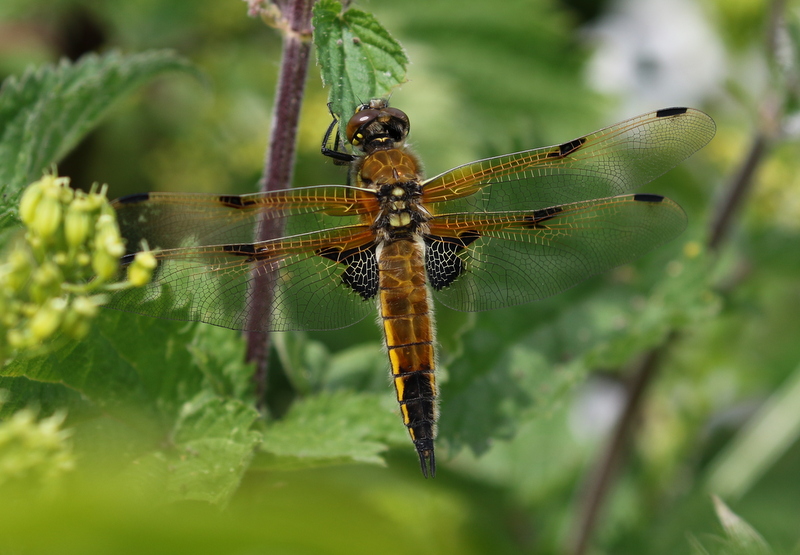 Four-spotted Chaser – on the brambles in the car park
Four-spotted Chaser – on the brambles in the car park
We had a look out at the field beyond the gate at the far end, but there was no sign of the Turtle Doves here either today. There were quite a few Red-legged Partridges and a pair of Oystercatchers, plus plenty of the ubiquitous Woodpigeons!
Before heading out to explore the reserve, we decided to have an early lunch. Afterwards, we made our way over to the visitor centre and then on up the main path. When we got to the reedbed, we could hear Reed Warblers singing and had nice views of a couple as they clambered around at the base of the reeds by one of the small pools. There were Sedge Warblers here too and we stopped to compare the two songs. Another Cetti’s Warbler showed itself briefly in the small sallows nearby a couple of times.
The Thornham grazing marsh ‘pool’ is still dry and fairly devoid of life – apart from lots of Woodpigeons and a single Little Egret in the ditch along the edge. There was more to see on the reedbed pool. In the back corner, we could see three drake Red-crested Pochards and we had a good look at them through the scope. A Little Grebe was diving in one of the reedbed channels nearby, until it was chased off by a Coot.
We could hear Bearded Tits calling, but at first the fleeting glimpses as they zoomed off over the reeds meant they were too fast for everyone to get onto. We noticed that several were flitting back and forth across the channel in the reeds, so eventually everyone at least got flight views.
There were lots of Black-headed Gulls flycatching over the reeds or the water and a single Common Tern was hovering over the reedbed pool. While we stood scanning the reeds, we heard a Mediterranean Gull calling and turned to see it flying off inland. After that, there was a steady stream of Mediterranean Gulls flying in and out of the freshmarsh in ones and twos, all adults with jet black hoods and white wing tips, their distinctive call giving them away every time.
 Mediterranean Gull – several were coming and going from the freshmarsh
Mediterranean Gull – several were coming and going from the freshmarsh
While we were standing by the reedbed, we could hear a Marsh Harrier calling. We looked up to see a tiny dot, high in the sky against the clouds. It was a male and it was displaying. We were treated to a spectacular sky dance, as it tumbled, somersaulted, looped-the-loop, twisted and turned. It gradually lost height as it made each loop and eventually dropped like a stone into a bush in the reedbed.
It was nice to get into Island Hide and out of the sun today. There was a nice selection of waders out on the freshmarsh. As well as the numerous Avocets (and quite a few Avocet chicks), there was a nice crowd of Bar-tailed Godwits roosting in the water, and a number of Black-tailed Godwits asleep on the island nearby. A single Black-tailed Godwit helpfully joined the Bar-taileds to allow us to get a side-by-side comparison.
 Avocet – lots on the freshmarsh, this one colour-ringed
Avocet – lots on the freshmarsh, this one colour-ringed
There was a single Ruff on the nearest island, a bright rufous necked male though with no ruff yet, together with a few Redshanks. The Little Stint was lurking on the back of the island where it was hard enough to see anyway, let alone when it was hiding behind all the birds legs in front! We eventually got a good look at it through the scope. A Little Ringed Plover was less helpful, and flew off before we could all see it.
While we were carefully looking through the waders, someone else in the hide quiet announced ‘Spoonbill‘ and we looked over to see a very large white bird in the water next to all the godwits. Surely we couldn’t have missed that? We confirmed that it had in fact just dropped in. We had a great look at it through the scope, it was an immature Spoonbill, with extensively fleshy-coloured bill, presumably one of last year’s brood. It preened for a while, before starting to feed, head down, sweeping its bill from side to side.
 Spoonbill – this immature dropped into the freshmarsh
Spoonbill – this immature dropped into the freshmarsh
A single Little Tern was resting on the island over towards Parrinder Hide and more Common Terns were scattered around the Freshmarsh. A couple more Mediterranean Gulls appeared on the edge of the fenced off ‘gull island’. A Little Gull had been reported from here over the last couple of days and after a careful scan we found what we presumed was that bird over towards Parrinder Hide, asleep. It was a first summer Little Gull, but quite advanced, with quite an extensively black head.
Then when we scanned back towards the bank, we found another Little Gull on the water over there, this one with a mostly pale winter-type head. We made our way out of the hide and up onto the main path, where we could get much better close views of this second Little Gull.
 Little Gull – one of two 1st summers on the Freshmarsh today
Little Gull – one of two 1st summers on the Freshmarsh today
There were some ominous dark clouds now starting to gather to the south, so we headed round to Parrinder Hide next. The birds were much the same as we had seen from the other side, apart from a drake Common Pochard and a pair of Egyptian Geese in the fenced off island. One of the group picked up a family party of five Bearded Tits working their way along the base of the reeds right over the other side of the Freshmarsh – through the scope, we got slightly better views than we had earlier of them in flight.
We did also get a slightly better view of the three main ‘Littles’ from here – the Little Stint, the Little Tern and the darker headed of the two first summer Little Gulls. They all looked suitably diminutive next to their larger cousins, in particular the Little Stint was dwarfed by anything it stood close to. At one point it was chased off by an agressive Black-tailed Godwit.
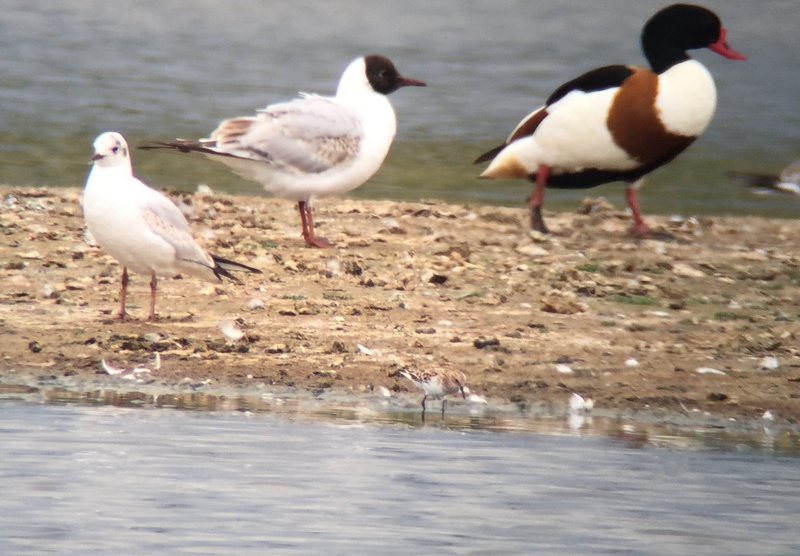 Little Stint – looking really tiny next to the Black-headed Gulls and Shelduck
Little Stint – looking really tiny next to the Black-headed Gulls and Shelduck
It looked like the dark clouds might be passing away to the south of us, so we decided to make a quick dash out to the beach. There wasn’t anything of note on the Volunteer Marsh, although we paused briefly to watch a Skylark dustbathing on the path nearby. A quick stop at the Tidal Pools revealed a small party of four Turnstones scattered over the islands. Two of the Turnstones were looking particularly smart in their summer plumage, with white faces and rich chestnut in the upperparts.
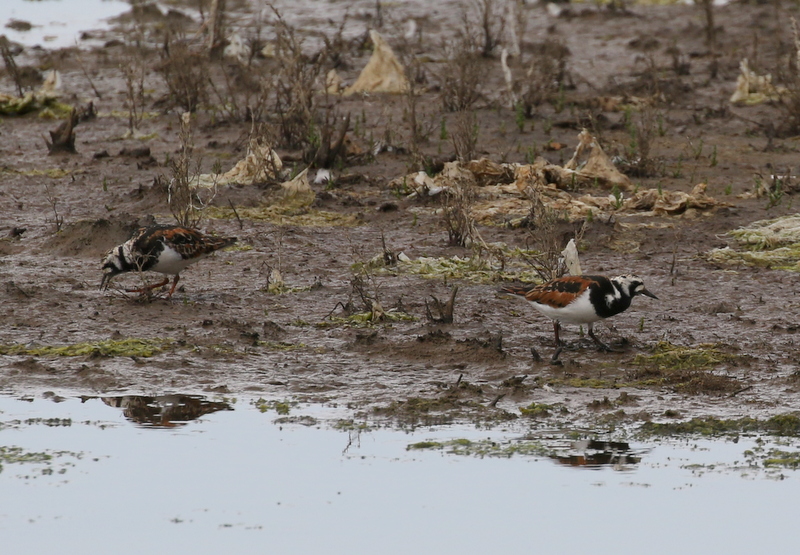 Turnstones – these two moulting into summer plumage
Turnstones – these two moulting into summer plumage
We could see a Little Tern hovering out over the Tidal Pools as we walked up, but now we were here, it settled down onto one of the islands and we realised there was actually a pair of them. We had a quick look at them in the scope.
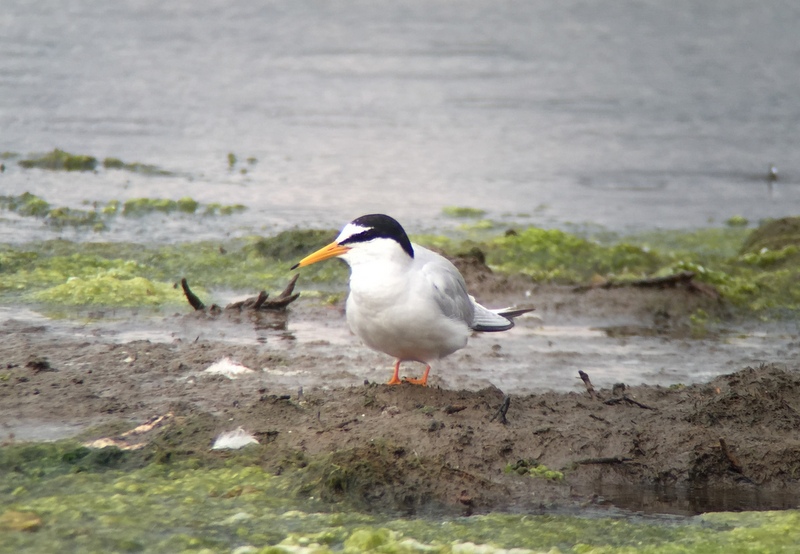 Little Tern – one of a pair on the Tidal Pools today
Little Tern – one of a pair on the Tidal Pools today
At this point it started to spit with rain. Given the very dark clouds just to the south, we thought it would be safer to head back to Parrinder Hide rather than continue on to the beach. As it was, the small amount of rain there was had all but stopped when we got back to the hide. Still, we sat inside for a few minutes while we waited to see what the weather was doing.
The Little Ringed Plover had reappeared on the edge of the nearest island, making our return visit worthwhile. We could see its golden yellow eye ring. Something spooked the flock of Bar-tailed Godwits which shifted them around and we looked over to see a single Knot had appeared with them, although it didn’t linger. Two Spoonbills flew west over the water in front of us and dropped down towards Thornham. These were adults, so different from the one we had seen earlier.
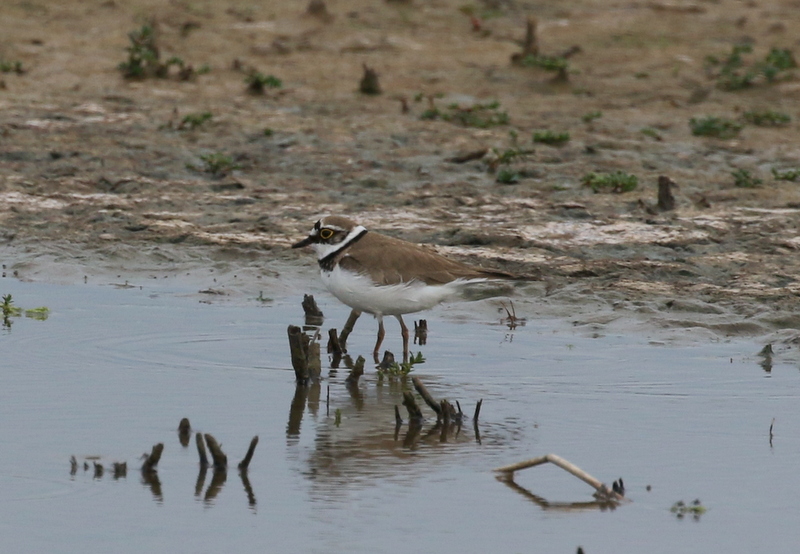 Little Ringed Plover – showing off its golden yellow eye ring
Little Ringed Plover – showing off its golden yellow eye ring
Given the rain seemed to have stopped, we set off to walk back. We had only just got onto the main path, when the rain started again. Typical! We hurried back to Island Hide to shelter. It rained quite hard for just a couple of minutes before it stopped once again. It did allow us to find a few birds we had not seen earlier.
A single drake Teal had appeared on the edge of one of the islands. Most of the Teal which spend the winter here have long since departed, but one or two are still lingering along the coast, so this was a bonus for the trip list. We had heard a Cuckoo earlier in the distance, but now we picked one up flying in from the trees beyond Patsy’s Reedbed, before landing in one of the dead trees over the far side of the reedbed. It was distant, but we got an OK view through the scope. There were now lots of Common Swifts hawking for insects over the back of the Freshmarsh in the rain.
We thought we could hear a Bittern booming, but there was just too much noise in the hide. Thankfully, we we walked round via Meadow Trail, we heard it again, much closer now and definitely a Bittern! A Chiffchaff was singing from the dead branches at the top of a tree and we heard a couple of Bullfinches calling from the sallows but couldn’t see them.
A quick look at Patsy’s Reedbed at least added Mute Swan to the day’s list – there was nothing much else of note out on there. A large group of Avocets flew in from the Freshmarsh, calling noisily. They landed on one bank for a few minutes before flying off back from where they had just come. The highlight here was a male Marsh Harrier perched up on a dead sapling in the reeds.
 Marsh Harrier – a male, perched up in the reeds
Marsh Harrier – a male, perched up in the reeds
As it started to spit with rain again, it was looking like it could get worse, so we beat a retreat back to the car. It was already getting late so we headed for home.
















